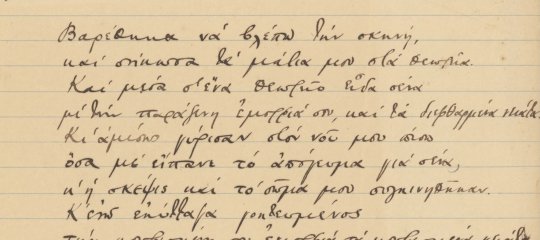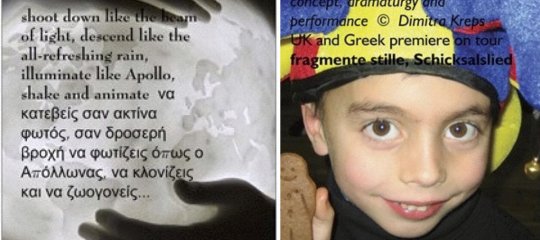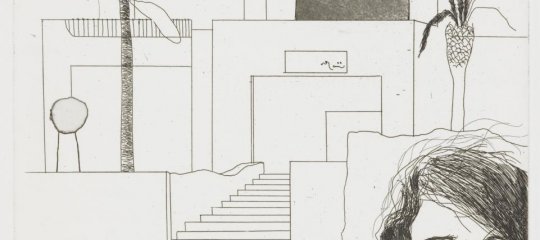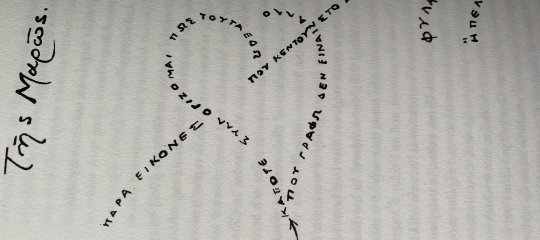Μια άλλη νύχτα: Μήδεια
Κυριακή Φραντζή
UNSW,Αυστραλία
Η αυστραλιανή ανεξάρτητη θεατρική παραγωγή, ίσως επειδή βρίσκεται μακριά από το βαρύ ίσκιο της ευρωπαϊκής παράδοσης, δίνει κατά καιρούς λαμπρά δείγματα δημιουργικής ανάπλασης κλασσικών έργων και μύθων. Δε διστάζει π.χ. να τρυπώσει πίσω από τις κουίντες του Οθέλλου του Σαίξπηρ και, αντί για την ασθματική δολοφονημένη στο τέλος ηρωίδα του, να παρουσιάσει μια επίσης ευαίσθητη Δεισδαιμόνα που ασφυκτιά, ονειρεύεται να γνωρίσει τον κόσμο,έχει διάφορους κρυφούς εραστές (όπως και ο Οθέλλος άλλωστε), και τη νύχτα του φόνου βρίσκει καταφύγιο -αντί για την αγκαλιά του συζύγου της- στη γυναίκα του Ιάγου που της χτενίζει ατέλειωτα ως το πρωί τα μαλλιά.
6 Ιουνίου 2003
Η παράσταση ωστόσο για την οποία θέλω να μιλήσω είναι παράσταση θεάτρου και ταυτόχρονα όπερας, έχει τον τίτλο Μια άλλη νύχτα:Μήδεια και βασίζεται σε τρία αντικρουόμενα κείμενα σχετικά με το μύθο της Μήδειας:
τα θεατρικά κείμενα του Γερμανού Heiner Műller: Ακτή της αποσύνθεσης, Μήδεια: Υλικό και τοπίο με Αργοναύτες (1983)
το θεατρικό έργο του Αμερικανού Edward Albee: Ποιος φοβάται τη Βιρτζίνια Γουλφ; (1962) και
τη γαλλική σόλο καντάτα του Louis Nicholas Clerambault: Μήδεια (αρχές 18ου αι).
Διαβάζω στο πρόγραμμα: «Δεν υπάρχει μόνο μια Μήδεια. Ο μυθικός Ιάσονας του Οβίδιου...δολοφονεί τους πολίτες και τους άρχοντες της Κολχίδας και παίρνει σαν τρόπαιο την πριγκίπισσά τους, την όμορφη Μήδεια. Παραδόξως ερωτεύονται, κάνουν παιδιά και εγκαθίστανται σε μια ξένη ακτή όπου οι ντόπιοι τους αντιμετωπίζουν σα μετανάστες...
...Ο Heiner Műller περιγράφει το μύθο του Ιάσονα σαν το πρωιμότερο δείγμα αποικιοκρατίας στον ελληνικό μύθο. «Το τέλος (εν. του μύθου) σηματοδοτεί το κατώφλι όπου ο μύθος μετατρέπεται σε ιστορία. Ο Ιάσονας τελικά συνθλίβεται από την Αργώ του. Η Ευρωπαική ιστορία άρχισε με έναν αποικισμό. Το γεγονός ότι το όχημα της αποικιοκρατίας σκοτώνει τον άποικο, προφητεύει και την κατάληξή της. Αυτή την απειλή του τέλους αντιμετωπίζουμε...».
Η καντάτα του Kλεραμπώ «διαβάζει» την ιστορία της Μήδειας σαν μια περίπλοκη ψυχολογικά «τραγωδία εκδίκησης». Έχοντας συνείδηση των εκλεπτυσμένων ηθών της εποχής του ο ανώνυμος στιχουργός της καντάτας βάζει τον αέρα-Μήδεια, μέσα από αλλεπάλληλες εκφράσεις συναισθημάτων αγάπης και μίσους για τον Ιάσονα, να καλεί τις Ερινύες να καταστρέψουν συθέμελα το παλάτι του και μαζί την ερωτική της αντίζηλο.Και τελειώνει την ιστορία προτού η Μήδεια σκοτώσει τα παιδιά..
Το έργο σκηνικά παίζεται σε δύο επίπεδα. Στο βάθος και πίσω σκηνή όπερας, ορχήστρα και η καντάτα του Κλεραμπώ που παριστάνει -κατά την παράδοση του μουσικού θεάτρoυ μπαρόκ- και τραγουδά στα γαλλικά ένα Ινδονήσιος με θηλυκό όνομα. Μπροστά εκτυλίσσεται σε κανονική σκηνή θεάτρου ο άγονος αγώνας αγάπης, προδοσίας και εκδίκησης ενός οποιουδήποτε ζευγαριού μέσης ηλικίας. Οι διάλογοι της Μήδειας και του Ιάσονα συνομιλούν και διαπλέκονται με τους διαλόγους της Μάρθας και του Τζωρτζ (από το έργο του Aλμπυ), που ερμηνεύονται από το ίδιο ζευγάρι ηθοποιών. Τα παιδιά των πρώτων, ο φανταστικός γιος των δεύτερων, θυσιάζονται συμβολικά και πραγματικά σ΄αυτό το άγριο ανταγωνιστικό παιγνίδι.Ο τραγουδιστής της καντάτας-Μήδεια κατεβαίνει και φλερτάρει με τη Μάρθα-Μήδεια. Ο Ιάσονας-Τζωρτζ αποπέμπει τον τραγουδιστή της καντάτας-Μήδεια. Το έργο τελειώνει αμφίβολα με τους πρωταγωνιστές να πηγαίνουν αποκαμωμένοι για ύπνο.
«Η σχέση της Μήδειας και του Ιάσονα» γράφει ο σκηνοθέτης στο πρόγραμμα «είναι κλασσικό παράδειγμα μακρόχρονιας δυσλειτουργικής σχέσης, της οποίας ο μύθος δίνει μόνο την αρχή και το αιματηρό τέλος. Αυτό το κενό αναλαμβάνει να αναπληρώσει στην παράσταση το έργο του Aλμπυ...Τι παρουσιάζουμε; Οβίδιο; Ευριπίδη; Μύλλερ; Κλεραμπώ; Aλμπυ; Σε διαφορετικό χρόνο και τόπο, είναι όλες βαθειές αναγνώσεις αυτού του μύθου»
Μια εξαιρετική παράσταση.
Τενόρος ο Peretta Anggerek. Ανέβηκε στο Σύδνευ το Μάιο του 2003 από το Opera Project Inc. και το θεατροχώρο Performance Space από τον μαθητή του Suzuki Nigel Kellaway και πρωταγωνιστές τον ίδιο και τη Regina Heilmαnn.
- Εισέλθετε στο σύστημα για να υποβάλετε σχόλια










